 For me, Grenache is the quintessential summer grape. It is often an essential component of the red and rosé wines that we enjoy drinking during the warm and sunny season. It was also the theme of our latest wine tasting gathering where we blind-tasted six Grenache-based wines from Spain, Italy, Southern France, Australia, and California.
For me, Grenache is the quintessential summer grape. It is often an essential component of the red and rosé wines that we enjoy drinking during the warm and sunny season. It was also the theme of our latest wine tasting gathering where we blind-tasted six Grenache-based wines from Spain, Italy, Southern France, Australia, and California.Most likely, Grenache comes from Spain where it is known as Garnacha. The grape is extremely heat and drought resistant and thrives in warm and dry climates as well as in poor soils. As it ripens slowly, it can reach high sugar levels. Grenache can produce different wine styles varying from light, fruity rosés, thanks to its thin skin with little pigment on it, to full-bodied reds and rich dessert wines. In the south of France, it is traditionally blended with Syrah, Mourvèdre, Cinsaut, and Carignan, in Spain, with Tempranillo and in Australia, with Syrah and Mourvèdre in the so called GSM wines. In California, Grenache counts to only 2.6% of the total wine grape acreage but a growing number of wineries known as the Rhone Rangers are dedicated to actively promoting the Rhône varieties in California, including Grenache.
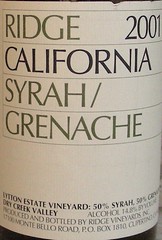 Ridge Vineyards is one of the Rhone Rangers member wineries. The winery produces various rhone style wines using Carignan, Grenache, Mourvèdre, Petite Sirah, and Syrah grapes. The 50% Syrah/ 50% Grenache blend from Ridge's Lytton Estate was the first wine that we tasted. The Lytton estate is located north of Healdsburg, on the hills separating Alexander Valley from Dry Creek Valley. Ridge's involvement with Grenache in the early 70s happened quite by accident when a high percentage of Grenache vine interplanted with small amounts of Zinfandel and Petite Sirah was discovered on one of the hills. Since then, Ridge bought additional vineyards including a thirty-two-year-old mixed Grenache blockland and 3.2 acres of mature syrah. The 2001 Ridge Syrah/Grenache Lytton Estate had a deep garnet color and a bright nose of sweet vanilla and red berries. On the palate, it was rich, slightly tannic, and well balanced with tasty sweet fruit flavors and a mineral-iron finish. Half of us ranked it first which put the wine in first position.
Ridge Vineyards is one of the Rhone Rangers member wineries. The winery produces various rhone style wines using Carignan, Grenache, Mourvèdre, Petite Sirah, and Syrah grapes. The 50% Syrah/ 50% Grenache blend from Ridge's Lytton Estate was the first wine that we tasted. The Lytton estate is located north of Healdsburg, on the hills separating Alexander Valley from Dry Creek Valley. Ridge's involvement with Grenache in the early 70s happened quite by accident when a high percentage of Grenache vine interplanted with small amounts of Zinfandel and Petite Sirah was discovered on one of the hills. Since then, Ridge bought additional vineyards including a thirty-two-year-old mixed Grenache blockland and 3.2 acres of mature syrah. The 2001 Ridge Syrah/Grenache Lytton Estate had a deep garnet color and a bright nose of sweet vanilla and red berries. On the palate, it was rich, slightly tannic, and well balanced with tasty sweet fruit flavors and a mineral-iron finish. Half of us ranked it first which put the wine in first position.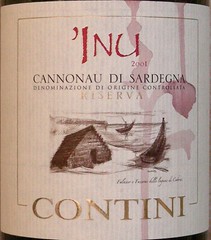 The second wine took us to Sardinia where Grenache is known as Cannonau. Grenache was probably brought there by the Spaniards during their rule of the island between the 15th and the 17th centuries. The 2001 Contini Cannonau di Sardegna Riserva 'Inu had a dark color and a spicy and fruity nose. On the palate, it was full-flavored with a characteristic Grenache taste. That was a pleasant wine that ended up in the fourth position.
The second wine took us to Sardinia where Grenache is known as Cannonau. Grenache was probably brought there by the Spaniards during their rule of the island between the 15th and the 17th centuries. The 2001 Contini Cannonau di Sardegna Riserva 'Inu had a dark color and a spicy and fruity nose. On the palate, it was full-flavored with a characteristic Grenache taste. That was a pleasant wine that ended up in the fourth position.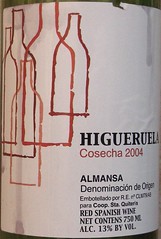 Our third wine came from Almansa, a little-known wine region located in Spain's Castilla-La Mancha. The 2004 Bodegas Tintoralba Higueruela gained significant notoriety when it was rated 90 points by Robert Parker. The wine had a spicy nose of sour cherry and blackberry. On the palate, it was smooth and concentrated with some acidity and a fruity aftertaste. The wine finished second.
Our third wine came from Almansa, a little-known wine region located in Spain's Castilla-La Mancha. The 2004 Bodegas Tintoralba Higueruela gained significant notoriety when it was rated 90 points by Robert Parker. The wine had a spicy nose of sour cherry and blackberry. On the palate, it was smooth and concentrated with some acidity and a fruity aftertaste. The wine finished second.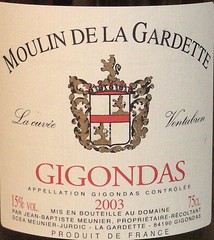 Our fourth wine was the 2003 Gigondas Moulin de la Gardette Cuvée Ventabren. The winery name Moulin de la Gardette refers to an old windmill that once stood on the stony hill of La Gardette just outside the village of Gigondas Designed for long term aging, the Cuvée Ventabren is a blend of 70% Grenache from very old vines, 20% Syrah and 10% Cinsault. The wine had a dark red color and a nose of raspberry liqueur. On the palate, it was still tight and tannic with sweet and peppery flavors. The wine finished in fifth position.
Our fourth wine was the 2003 Gigondas Moulin de la Gardette Cuvée Ventabren. The winery name Moulin de la Gardette refers to an old windmill that once stood on the stony hill of La Gardette just outside the village of Gigondas Designed for long term aging, the Cuvée Ventabren is a blend of 70% Grenache from very old vines, 20% Syrah and 10% Cinsault. The wine had a dark red color and a nose of raspberry liqueur. On the palate, it was still tight and tannic with sweet and peppery flavors. The wine finished in fifth position.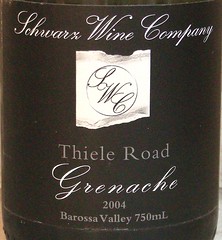 Our fifth wine, the 2004 Jason Schwarz Thiele Road Grenache Barossa Valley, came from the Barossa Valley in South Australia where Grenache vines are some of the oldest in Australia. Jason Schwarz is the son of an independent grape grower with over 100 acres of vineyards in the Barossa Valley. In 2001, Jason decided to make his own wine and now produces a Syrah and a Grenache from the family vineyards. The nose of the 2004 Grenache was sweet and spicy. The palate was big with sweet strawberry candy and raisin flavors and some definite heat on the finish. For me, the wine was too sweet with too much alcohol and I found out later that the 2004 vintage had an unusual 16% alcohol and 6 grams/litre of residual sugar. The wine was ranked last.
Our fifth wine, the 2004 Jason Schwarz Thiele Road Grenache Barossa Valley, came from the Barossa Valley in South Australia where Grenache vines are some of the oldest in Australia. Jason Schwarz is the son of an independent grape grower with over 100 acres of vineyards in the Barossa Valley. In 2001, Jason decided to make his own wine and now produces a Syrah and a Grenache from the family vineyards. The nose of the 2004 Grenache was sweet and spicy. The palate was big with sweet strawberry candy and raisin flavors and some definite heat on the finish. For me, the wine was too sweet with too much alcohol and I found out later that the 2004 vintage had an unusual 16% alcohol and 6 grams/litre of residual sugar. The wine was ranked last.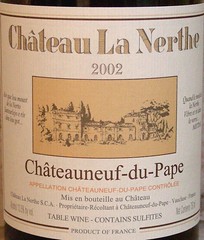 Our last wine came from Château La Nerthe, one of the main producers in Châteauneuf-du-Pape and one of the most historic domains in France—the wines of Château La Nerthe were served at the court of Louis XVI in Versailles. One of the property's owner was the eminent Commandant Joseph Ducos, the first French grower who imported American rootstock to overcome the phylloxera epidemic, and who is remembered as the soul of the viticultural reconstitution. The 2002 Châteauneuf-du-Pape Château La Nerthe had a medium ruby color and a earthy nose of sweet berry and jasmine aromas. The palate was round, fruity, and peppery. For a Châteauneuf-du-Pape, the wine was rather light and easily overpowered by the Schwarz Thiele Road Grenache (2002, known as the "flood" vintage, produced light wines in the Southern Rhône). But, as the dinner progressed, I found the wine to be one of the most food friendly and balanced of the tasting. The wine finished in third position.
Our last wine came from Château La Nerthe, one of the main producers in Châteauneuf-du-Pape and one of the most historic domains in France—the wines of Château La Nerthe were served at the court of Louis XVI in Versailles. One of the property's owner was the eminent Commandant Joseph Ducos, the first French grower who imported American rootstock to overcome the phylloxera epidemic, and who is remembered as the soul of the viticultural reconstitution. The 2002 Châteauneuf-du-Pape Château La Nerthe had a medium ruby color and a earthy nose of sweet berry and jasmine aromas. The palate was round, fruity, and peppery. For a Châteauneuf-du-Pape, the wine was rather light and easily overpowered by the Schwarz Thiele Road Grenache (2002, known as the "flood" vintage, produced light wines in the Southern Rhône). But, as the dinner progressed, I found the wine to be one of the most food friendly and balanced of the tasting. The wine finished in third position.
3 comments:
Acidic Grenache! Maybe I'll bite after all. I find Grenache to be so often lacking in acidity that I avoid it. Especially since I'm always drinking wine at meals when the acid is needed.
So #2 Almansa is definitely is one I'll look out for.
Do you know if serving temperature has an impact on the expression of acid in wine? I was thinking maybe that is why majority Grenache wines seem better when served on the cool side.
We opened this tasting with a fine, solid, mineral-and-fruit-laden Grenache Rose' from Pipestone Vineyards (http://www.pipestonevineyards.com/2005GrenacheRose.asp)
The Pipestone Grenache Rose' provided the right touch of dry Paso Robles hillside, with overlays of vineyard-fruit near the Pipestone winery. This wine is worth checking out -- as, actually, are all the wines from Jeff Pipes and Florence Wong at Pipestone.
thanks for the Pipestone Rosé tasting notes! I guess I missed this one from our tasting.
Post a Comment